Effect of Carbon Nanotubes on Chloride Diffusion, Strength, and Microstructure of Ultra-High Performance Concrete
Abstract
1. Introduction
2. Materials and Mix Design
2.1. Materials
2.2. Carbon Nanotube
2.3. Mix Proportion
3. Experimental Methods
3.1. Flow Test
3.2. Compressive and Tensile Strength
3.3. Microstructure and Phase Composition Analysis
3.4. Accelerated Chloride Penetration
3.5. Prediction of Service Life Model
4. Results and Discussion
4.1. Fresh Properties
4.2. Compressive Strength
4.3. Tensile Strength
4.4. SEM Investigation
4.5. XRD Analysis
- Quartz is a common crystalline phase found in aggregates, particularly if natural aggregates or silica-based materials are utilized in the concrete mix.
- Alite (Tricalcium silicate), a fundamental component of OPC, is expected in UHPC containing OPC.
- Some materials in the mix may exist in an amorphous or non-crystalline form, and XRD is less sensitive to such phases.
- The materials employed, including silica fume and silica powder, consist of extremely fine particles. Consequently, XRD may not identify them as distinct crystalline phases.
- The mix composition may favor non-crystalline or amorphous forms, resulting in fewer distinguishable crystalline peaks.
- XRD’s sensitivity limits might preclude the detection of phases present in small quantities or exhibiting weak diffraction signals.
- A homogenized mix design could lead to the dominance of main crystalline phases, posing challenges in identifying minor phases.
4.6. Ponding Test Results
4.7. Life Service Prediction
5. Conclusions
- Elevating the concentration of CNT in CNT1 and CNT2 blends resulted in a marginal enhancement in compressive strength compared to the control mix. Conversely, the CNT3 mixture demonstrated a reduction in compressive strength with an increasing content of CNT as an admixture. Furthermore, the compressive strength values at 3, 7, and 28 days in the salty curing environment were significantly inferior to those recorded under air curing periods.
- The outcomes of tensile strength testing revealed that as the quantity of CNT increased as an admixture, the tensile strength of CNT mixtures experienced a slight decline across all curing periods. This phenomenon can be ascribed to the nuanced interaction between CNTs and the cementitious matrix. While CNTs have the potential to enhance compressive strength by acting as additional bridges and reinforcing the concrete structure, the nature of their bonding with the cementitious matrix plays a critical role in load transfer. In instances where this bonding is not optimally established, a reduction in tensile strength occurs, as observed in the present study.
- Examination through SEM indicated that an augmented concentration of CNTs as an admixture in the concrete led to the formation of nanoscale bridges within the concrete matrix. These bridges, at the nanoscale level, act as reinforcement, establishing a network within the cementitious matrix. This network plays a crucial role in significantly enhancing the distribution and transfer of loads, thereby slightly improving the overall strength performance of the concrete during both the 3-day and 28-day normal curing periods. Furthermore, an analysis of the EDS map sum spectrum outcomes revealed that the primary elements in the structure of all mixtures include O, Si, C, and Ca, albeit in varying proportions.
- Drawing insights from the XRD analysis outcomes, it is discerned that, across all samples, the principal crystalline phases identified after both the 3-day and 28-day curing periods consist of Quartz and Alite. This occurrence can be attributed to the potential presence of certain materials in the mix in an amorphous or non-crystalline form, a condition where XRD exhibits diminished sensitivity. Furthermore, a well-homogenized mix design may result in the prevalence of dominant crystalline phases, presenting difficulties in discerning minor phases.
- Upon scrutinizing the ponding test results, it was evident that, for all samples, the effective chloride transport coefficient remained below the standard limitation of 1.00 × 10−12 m2/s, indicating that the performance of all samples in the ponding test fell within an acceptable range. However, upon a more detailed examination, it was noted that the chloride transport coefficient experienced a decrease with an increase in the amount of CNT up to 0.05% (as observed in CNT1 and CNT2 mixes in comparison to the control mix). In contrast, for the CNT3 mixture, there was an increase relative to the control mix. This observed trend aligned with the compressive strength outcomes, where the strength of the CNT1 and CNT2 mixtures surpassed that of the CNT3 mixture.
- The life service prediction outcomes indicate that in every environmental scenario, CNT1 and CNT2 mixtures demonstrated superior performance when compared to all other mixtures. These findings closely mirror the strength performance results, where CNT1 and CNT2 mixtures showcased excellence in both compressive strength and life service prediction. The effective dispersion of CNT in these two mixtures is credited for this superior performance, facilitating the formation of additional bridges between the cement paste and ALA and MHS particles resulting in the creation of more impermeable concrete.
Author Contributions
Funding
Institutional Review Board Statement
Informed Consent Statement
Data Availability Statement
Conflicts of Interest
References
- Saleh, S.; Mahmood, A.H.; Hamed, E.; Zhao, X.L. The mechanical, transport and chloride binding characteristics of ultra-high-performance concrete utilising seawater, sea sand and SCMs. Constr. Build. Mater. 2023, 372, 130815. [Google Scholar] [CrossRef]
- Bogas, J.A.; Gomes, A. Non-steady-state accelerated chloride penetration resistance of structural lightweight aggregate concrete. Cem. Concr. Compos. 2015, 60, 111–122. [Google Scholar] [CrossRef]
- Cai, R.; Tian, Z.; Ye, H. Durability characteristics and quantification of ultra-high strength alkali-activated concrete. Cem. Concr. Compos. 2022, 134, 104743. [Google Scholar] [CrossRef]
- Rafieizonooz, M.; Mirza, J.; Salim, M.R.; Hussin, M.W.; Khankhaje, E. Investigation of coal bottom ash and fly ash in concrete as replacement for sand and cement. Constr. Build. Mater. 2016, 116, 15–24. [Google Scholar] [CrossRef]
- Rafieizonooz, M.; Khankhaje, E.; Rezania, S. Assessment of environmental and chemical properties of coal ashes including fly ash and bottom ash, and coal ash concrete. J. Build. Eng. 2022, 49, 104040. [Google Scholar] [CrossRef]
- Luo, Z.; Zhi, T.; Liu, X.; Yin, K.; Pan, H.; Feng, H.; Song, Y.; Su, Y. Effects of different nanomaterials on the early performance of ultra-high performance concrete (UHPC): C–S–H seeds and nano-silica. Cem. Concr. Compos. 2023, 142, 105211. [Google Scholar] [CrossRef]
- Yu, L.; Bai, S.; Guan, X. Effect of graphene oxide on microstructure and micromechanical property of ultra-high performance concrete. Cem. Concr. Compos. 2023, 138, 104964. [Google Scholar] [CrossRef]
- Song, B.; Liu, S.; Hu, X.; Ouyang, K.; Li, G.; Shi, C. Compressive strength, water and chloride transport properties of early CO2-cured Portland cement-fly ash-slag ternary mortars. Cem. Concr. Compos. 2022, 134, 104786. [Google Scholar] [CrossRef]
- Afzal, M.T.; Khushnood, R.A. Influence of carbon nano fibers (CNF) on the performance of high strength concrete exposed to elevated temperatures. Constr. Build. Mater. 2021, 268, 121108. [Google Scholar] [CrossRef]
- Oh, T.; Chun, B.; Lee, S.K.; Kim, G.W.; Banthia, N.; Yoo, D.-Y. Effect of high-volume substituted nanosilica on the hydration and mechanical properties of Ultra-High-Performance Concrete (UHPC). Cem. Concr. Res. 2024, 175, 107379. [Google Scholar] [CrossRef]
- Zhang, G.; Peng, G.F.; Zuo, X.Y.; Niu, X.J.; Ding, H. Adding hydrated lime for improving microstructure and mechanical properties of mortar for ultra-high performance concrete. Cem. Concr. Res. 2023, 167, 107130. [Google Scholar] [CrossRef]
- Wang, X.; Yu, R.; Song, Q.; Shui, Z.; Liu, Z.; Wu, S.; Hou, D. Optimized design of ultra-high performance concrete (UHPC) with a high wet packing density. Cem. Concr. Res. 2019, 126, 105921. [Google Scholar] [CrossRef]
- Jiang, J.; Qin, J.; Chu, H. Improving mechanical properties and microstructure of ultra-high-performance lightweight concrete via graphene oxide. J. Build. Eng. 2023, 80, 108038. [Google Scholar] [CrossRef]
- Esmaeili, J.; Romouzi, V.; Kasaei, J.; Andalibi, K. An investigation of durability and the mechanical properties of ultra-high performance concrete (UHPC) modified with economical graphene oxide nano-sheets. J. Build. Eng. 2023, 80, 107908. [Google Scholar] [CrossRef]
- Rosa, R.E.M.; Corr, D.J.; Espinosa, H.D.; Shah, S.P. Characterization of adhesion strength between carbon nanotubes and cementitious materials. Cem. Concr. Compos. 2023, 138, 104953. [Google Scholar] [CrossRef]
- Hussain, A.; Xiang, Y.; Yu, T.; Zou, F. Nanocarbon black-based ultra-high-performance concrete (UHPC) with self-strain sensing capability. Constr. Build. Mater. 2022, 359, 129496. [Google Scholar] [CrossRef]
- Zhang, P.; Su, J.; Guo, J.; Hu, S. Influence of carbon nanotube on properties of concrete: A review. Constr. Build. Mater. 2023, 369, 130388. [Google Scholar] [CrossRef]
- Narasimman, K.; Jassam, T.M.; Velayutham, T.S.; Yaseer, M.M.M.; Ruzaimah, R. The synergic influence of carbon nanotube and nanosilica on the compressive strength of lightweight concrete. J. Build. Eng. 2020, 32, 101719. [Google Scholar] [CrossRef]
- Li, L.; Wang, B.; Hubler, M.H. Carbon nanofibers (CNFs) dispersed in ultra-high performance concrete (UHPC): Mechanical property, workability and permeability investigation. Cem. Concr. Compos. 2022, 131, 104592. [Google Scholar] [CrossRef]
- Li, C.; Li, J.; Ren, Q.; Zheng, Q.; Jiang, Z. Durability of concrete coupled with life cycle assessment: Review and perspective. Cem. Concr. Compos. 2023, 139, 105041. [Google Scholar] [CrossRef]
- Li, K.; Han, J.; Wang, S.; Lian, H.; Xiong, J.; Wang, J.; Fan, Z.; Xu, L.; Zhu, H. Long-term performance of structural concretes in China southeast coastal environments exposed to atmosphere and chlorides. Cem. Concr. Res. 2023, 164, 107064. [Google Scholar] [CrossRef]
- Jung, M.; Lee, Y.S.; Hong, S.G.; Moon, J. Carbon nanotubes (CNTs) in ultra-high performance concrete (UHPC): Dispersion, mechanical properties, and electromagnetic interference (EMI) shielding effectiveness (SE). Cem. Concr. Res. 2020, 131, 106017. [Google Scholar] [CrossRef]
- Jayakumari, B.Y.; Swaminathan, E.N.; Partheeban, P. A review on characteristics studies on carbon nanotubes-based cement concrete. Constr. Build. Mater. 2023, 367, 130344. [Google Scholar] [CrossRef]
- D’Alessandro, A.; Ubertini, F.; Materazzi, A.L.; Laflamme, S.; Porfiri, M. Electromechanical modelling of a new class of nanocomposite cement-based sensors for structural health monitoring. Struct. Health Monit. 2015, 14, 137–147. [Google Scholar] [CrossRef]
- Aydın, A.C.; Nasl, V.J.; Kotan, T. The synergic influence of nano-silica and carbon nano tube on self-compacting concrete. J. Build. Eng. 2018, 20, 467–475. [Google Scholar] [CrossRef]
- Yoo, D.Y.; Oh, T.; Banthia, N. Nanomaterials in ultra-high-performance concrete (UHPC)—A review. Cem. Concr. Compos. 2022, 134, 104730. [Google Scholar] [CrossRef]
- Mudasir, P.; Naqash, J.A. Impact of carbon Nano tubes on fresh and hardned properties of conventional concrete. Mater. Today Proc. 2023, 80, 1920–1925. [Google Scholar] [CrossRef]
- Shen, P.; Lu, L.; He, Y.; Wang, F.; Hu, S. The effect of curing regimes on the mechanical properties, nano-mechanical properties and microstructure of ultra-high performance concrete. Cem. Concr. Res. 2019, 118, 1–13. [Google Scholar] [CrossRef]
- Jung, M.; Park, J.S.; Hong, S.G.; Moon, J. Micro- and meso-structural changes on electrically cured ultra-high performance fiber-reinforced concrete with dispersed carbon nanotubes. Cem. Concr. Res. 2020, 137, 106214. [Google Scholar] [CrossRef]
- Shafikhani, M.; Chidiac, S.E. Quantification of concrete chloride diffusion coefficient—A critical review. Cem. Concr. Compos. 2019, 99, 225–250. [Google Scholar] [CrossRef]
- De Weerdt, K.; Wilson, W.; Machner, A.; Georget, F. Chloride profiles—What do they tell us and how should they be used? Cem. Concr. Res. 2023, 173, 107287. [Google Scholar] [CrossRef]
- Sanjuán, M.Á.; Rivera, R.A.; Martín, D.A.; Estévez, E. Chloride Diffusion in Concrete Made with Coal Fly Ash Ternary and Ground Granulated Blast-Furnace Slag Portland Cements. Materials 2022, 15, 8914. [Google Scholar] [CrossRef] [PubMed]
- Dong, H.; Wang, J. Carbon nanofibers and polyvinyl-alcohol fiber hybrid-reinforced high-performance concrete: Mechanical property, chloride penetration resistance, and material characterization. Constr. Build. Mater. 2023, 399, 131891. [Google Scholar] [CrossRef]
- Liu, Q.F.; Cai, Y.; Peng, H.; Meng, Z.; Mundra, S.; Castel, A. A numerical study on chloride transport in alkali-activated fly ash/slag concretes. Cem. Concr. Res. 2023, 166, 107094. [Google Scholar] [CrossRef]
- Lehner, P.; Konečný, P.; Ponikiewski, T. Comparison of material properties of scc concrete with steel fibres related to ingress of chlorides. Crystals 2020, 10, 220. [Google Scholar] [CrossRef]
- Dehghan, A.; Peterson, K.; Riehm, G.; Bromerchenkel, L.H. Application of X-ray microfluorescence for the determination of chloride diffusion coefficients in concrete chloride penetration experiments. Constr. Build. Mater. 2017, 148, 85–95. [Google Scholar] [CrossRef]
- NT BUILD 443; Concrete, Hardened: Accelerated Chloride Penetration (NT BUILD 443). NORDTEST: Oslo, Norway, 1995. Available online: https://www.nordtest.info/wp/1995/11/22/concrete-hardened-accelerated-chloride-penetration-nt-build-443/ (accessed on 27 November 2023).
- ASTM C1543; Standard Test Method for Determining the Penetration of Chloride Ion into Concrete by Ponding (Withdrawn 2019). American Standard Test Method: West Conshohocken, PA, USA, 2019. Available online: https://www.astm.org/c1543-10a.html (accessed on 30 November 2023).
- ASTM C1556; Standard Test Method for Determining the Apparent Chloride Diffusion Coefficient of Cementitious Mixtures by Bulk Diffusion. American Standard Test Method: West Conshohocken, PA, USA, 2016. Available online: https://www.astm.org/c1556-11ar16.html (accessed on 30 November 2023).
- NT BUILD 492; Nordic Cooperation, Concrete, Mortar and Cement-Based Repair Materials: Chloride Migration Coefficient from Non-Steady-State Migration Experiments (NT BUILD 492). NORDTEST: Oslo, Norway, 1999. Available online: https://www.nordtest.info/wp/1999/11/21/concrete-mortar-and-cement-based-repair-materials-chloride-migration-coefficient-from-non-steady-state-migration-experiments-nt-build-492/ (accessed on 30 November 2023).
- Mapa, D.G.; Zhu, H.; Nosouhian, F.; Shanahan, N.; Riding, K.A.; Zayed, A. Chloride binding and diffusion of slag blended concrete mixtures. Constr. Build. Mater. 2023, 388, 131584. [Google Scholar] [CrossRef]
- Elfmarkova, V.; Spiesz, P.; Brouwers, H.J.H. Determination of the chloride diffusion coefficient in blended cement mortars. Cem. Concr. Res. 2015, 78, 190–199. [Google Scholar] [CrossRef]
- Runci, A.; Provis, J.; Serdar, M. Microstructure as a key parameter for understanding chloride ingress in alkali-activated mortars. Cem. Concr. Compos. 2022, 134, 104818. [Google Scholar] [CrossRef]
- Lim, T.; Lee, J.H.; Mun, J.H.; Yang, K.H.; Ju, S.; Jeong, S.M. Enhancing functionality of epoxy–TiO2-embedded high-strength lightweight aggregates. Polymers 2020, 12, 2384. [Google Scholar] [CrossRef]
- Sun, S.; Han, B.; Jiang, S.; Yu, X.; Wang, Y.; Li, H.; Ou, J. Nano graphite platelets-enabled piezoresistive cementitious composites for structural health monitoring. Constr. Build. Mater. 2017, 136, 314–328. [Google Scholar] [CrossRef]
- Ubertini, F.; Materazzi, A.L.; D’Alessandro, A.; Laflamme, S. Natural frequencies identification of a reinforced concrete beam using carbon nanotube cement-based sensors. Eng. Struct. 2014, 60, 265–275. [Google Scholar] [CrossRef]
- García-Macías, E.; D’Alessandro, A.; Castro-Triguero, R.; Pérez-Mira, D.; Ubertini, F. Micromechanics modeling of the uniaxial strain-sensing property of carbon nanotube cement-matrix composites for SHM applications. Compos. Struct. 2017, 163, 195–215. [Google Scholar] [CrossRef]
- Siahkouhi, M.; Razaqpur, G.; Hoult, N.A.; Baghban, M.H.; Jing, G. Utilization of carbon nanotubes (CNTs) in concrete for structural health monitoring (SHM) purposes: A review. Constr. Build. Mater. 2021, 309, 125137. [Google Scholar] [CrossRef]
- Qu, Z.Y.; Yu, Q.L.; Brouwers, H.J.H. Relationship between the particle size and dosage of LDHs and concrete resistance against chloride ingress. Cem. Concr. Res. 2018, 105, 81–90. [Google Scholar] [CrossRef]
- Guignone, G.C.; Vieira, G.L.; Zulcão, R.; Mion, G.; Baptista, G. Analysis of the chloride diffusion coefficients by different test methods in concrete mixtures containing metakaolin and high-slag blast-furnace cement. Rev. Mater. 2019, 24, e12512. [Google Scholar] [CrossRef]
- Stanish, K.; Hooton, D.; Thomas, M. Testing the Chloride Penetration Resistance of Concrete: A Literature Review; Federal Highway Administration: Washington, DC, USA, 1997. [Google Scholar]
- NT BUILD 208; Concrete, Hardened: Chloride Content by Volhard Titration (NT BUILD 208). NORDTEST: Oslo, Norway, 1996. Available online: https://www.nordtest.info/wp/1996/11/28/concrete-hardened-chloride-content-by-volhard-titration-nt-build-208/ (accessed on 27 November 2023).
- Ehlen, M.A.; Thomas, M.D.A.; Bentz, E.C. Life-365 Service Life Prediction ModelTM Version 2.0. Concr. Int. 2009, 31, 41–46. [Google Scholar]
- Moffatt, E.G.; Thomas, M.D.A.; Fahim, A. Performance of high-volume fly ash concrete in marine environment. Cem. Concr. Res. 2017, 102, 127–135. [Google Scholar] [CrossRef]
- KDS 14 20 40; Concrete Structure Durability Design Standards. KCSC: Seoul, Republic of Korea, 2021.
- Sun, Z.; Wan, S.G. Sachs, Compatibility of carbon nanotubes in concrete with air entrainer and superplasticizer. Constr. Build. Mater. 2023, 364, 129944. [Google Scholar] [CrossRef]
- Liang, T.; Zhou, J.; Wu, Q. Experimental investigation on leaching behavior of ultra-high performance concrete submitted to a flow environment. Constr. Build. Mater. 2023, 372, 130843. [Google Scholar] [CrossRef]
- Xu, Z.; Liu, Q.; Long, H.Y.; Deng, H.; Chen, Z.; Hui, D. Influence of nano-SiO2 and steel fiber on mechanical and microstructural properties of red mud-based geopolymer concrete. Constr. Build. Mater. 2023, 364, 129990. [Google Scholar] [CrossRef]
- Han, K.; Guo, T.; Shu, X.; Ran, Q.; Guo, Y.; Shi, J. Insight into the role of early C3A hydration in structural build-up of cement paste. Cem. Concr. Res. 2024, 175, 107354. [Google Scholar] [CrossRef]
- Bao, J.; Zheng, R.; Zhang, P.; Cui, Y.; Xue, S.; Song, Q.; Ma, Y. Thermal resistance, water absorption and microstructure of high-strength self-compacting lightweight aggregate concrete (HSSC-LWAC) after exposure to elevated temperatures. Constr. Build. Mater. 2023, 365, 130071. [Google Scholar] [CrossRef]
- Liu, C.; Zhang, M. Microstructure-based modelling of chloride diffusivity in non-saturated cement paste accounting for capillary and gel pores. Cem. Concr. Res. 2023, 168, 107153. [Google Scholar] [CrossRef]
- Moon, J.; Bae, S.; Celik, K.; Yoon, S.; Kim, K.-H.; Kim, K.S.; Monteiro, P.J.M. Characterization of natural pozzolan-based geopolymeric binders. Cem. Concr. Compos. 2014, 53, 97–104. [Google Scholar] [CrossRef]
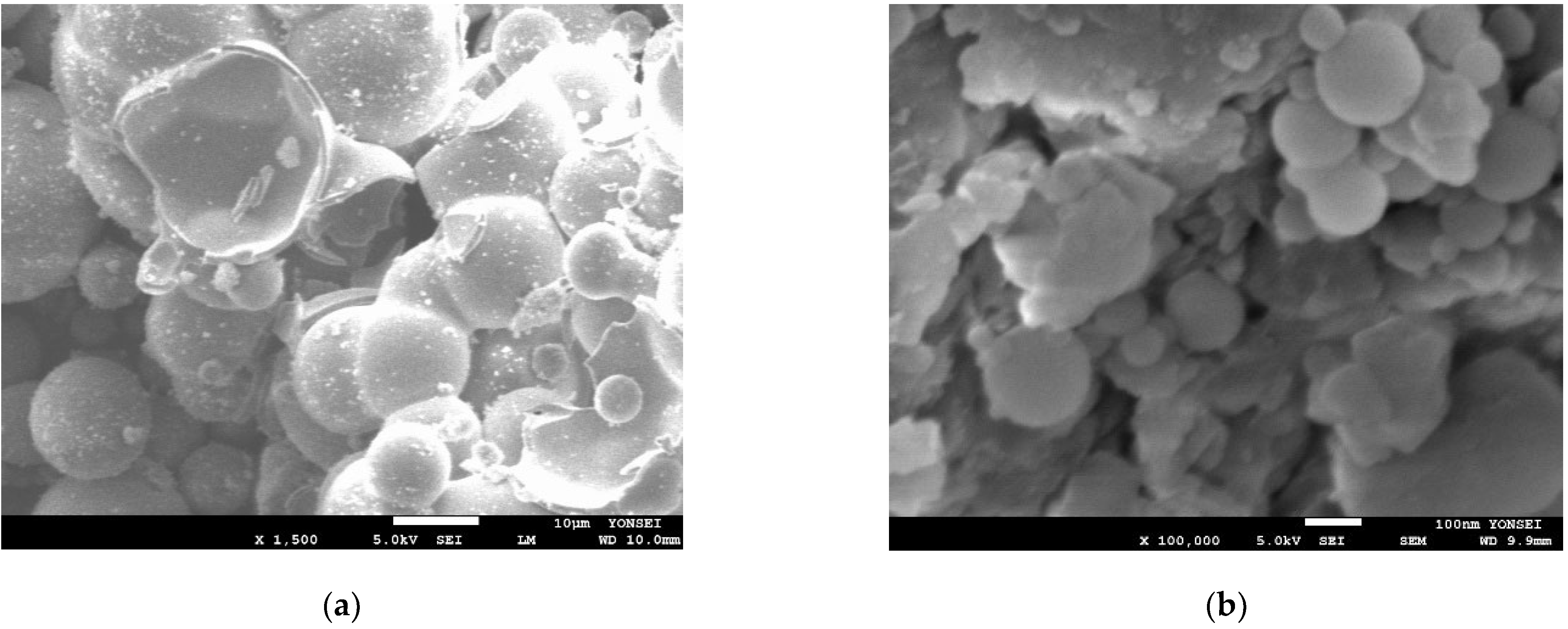


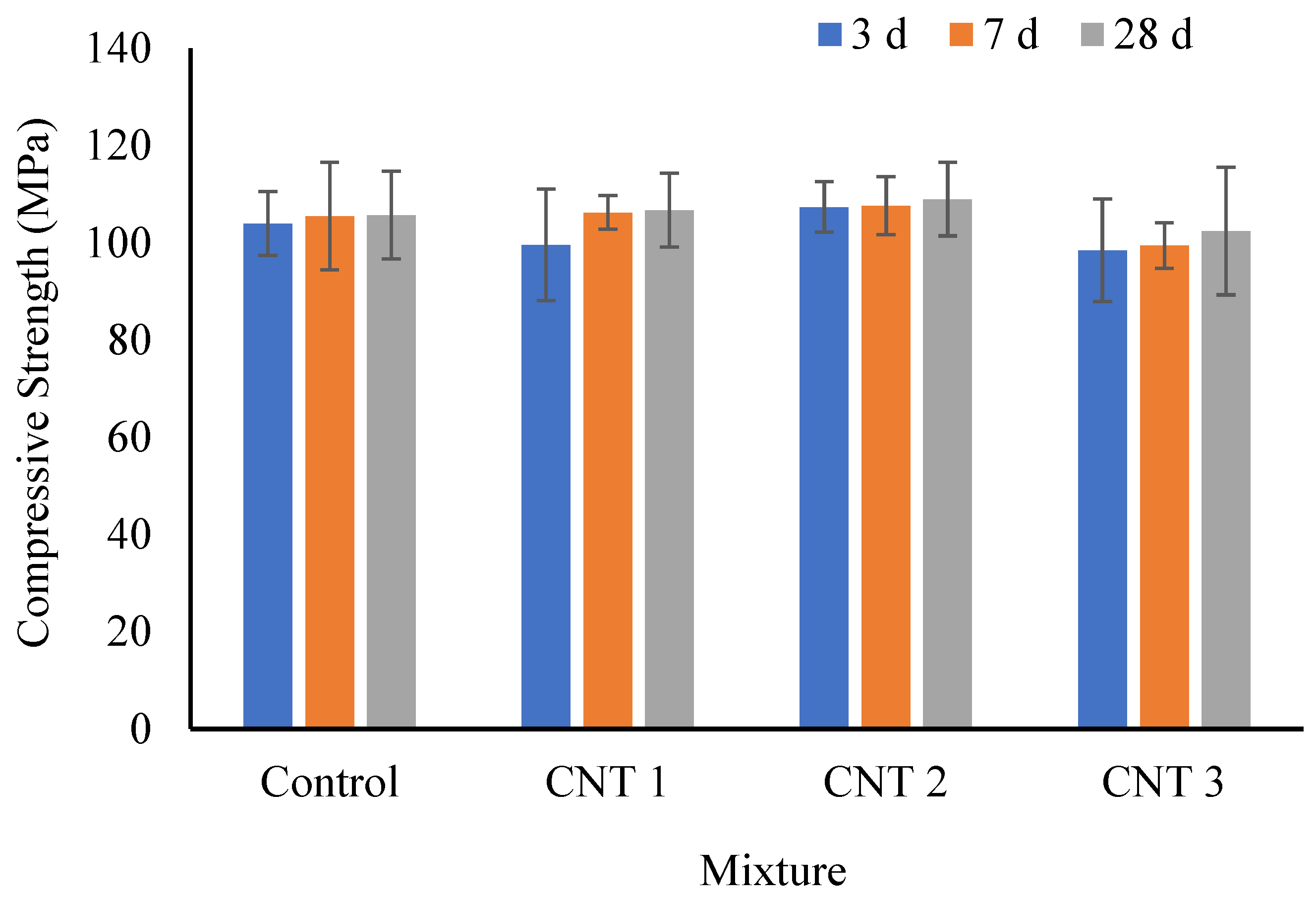
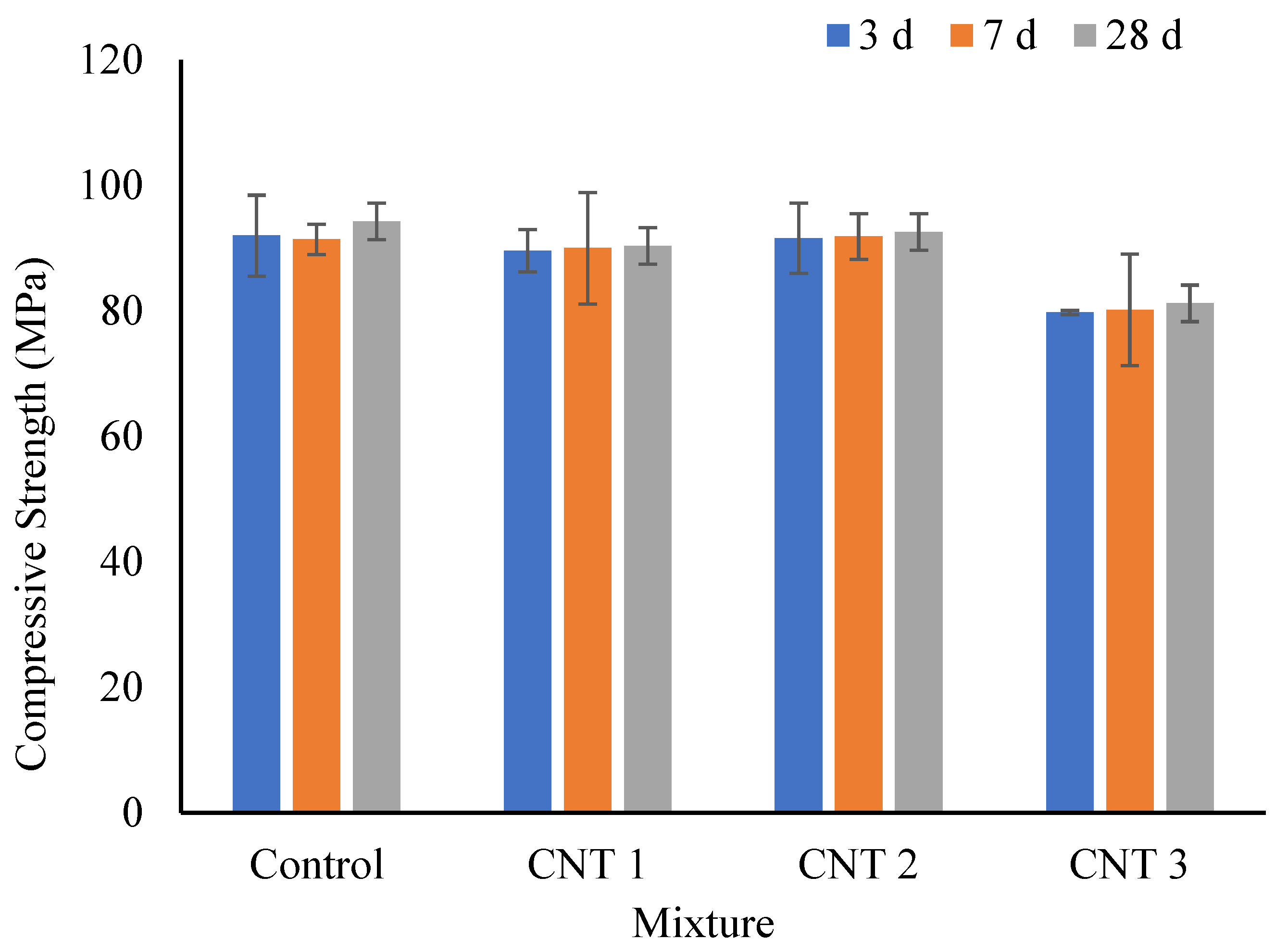
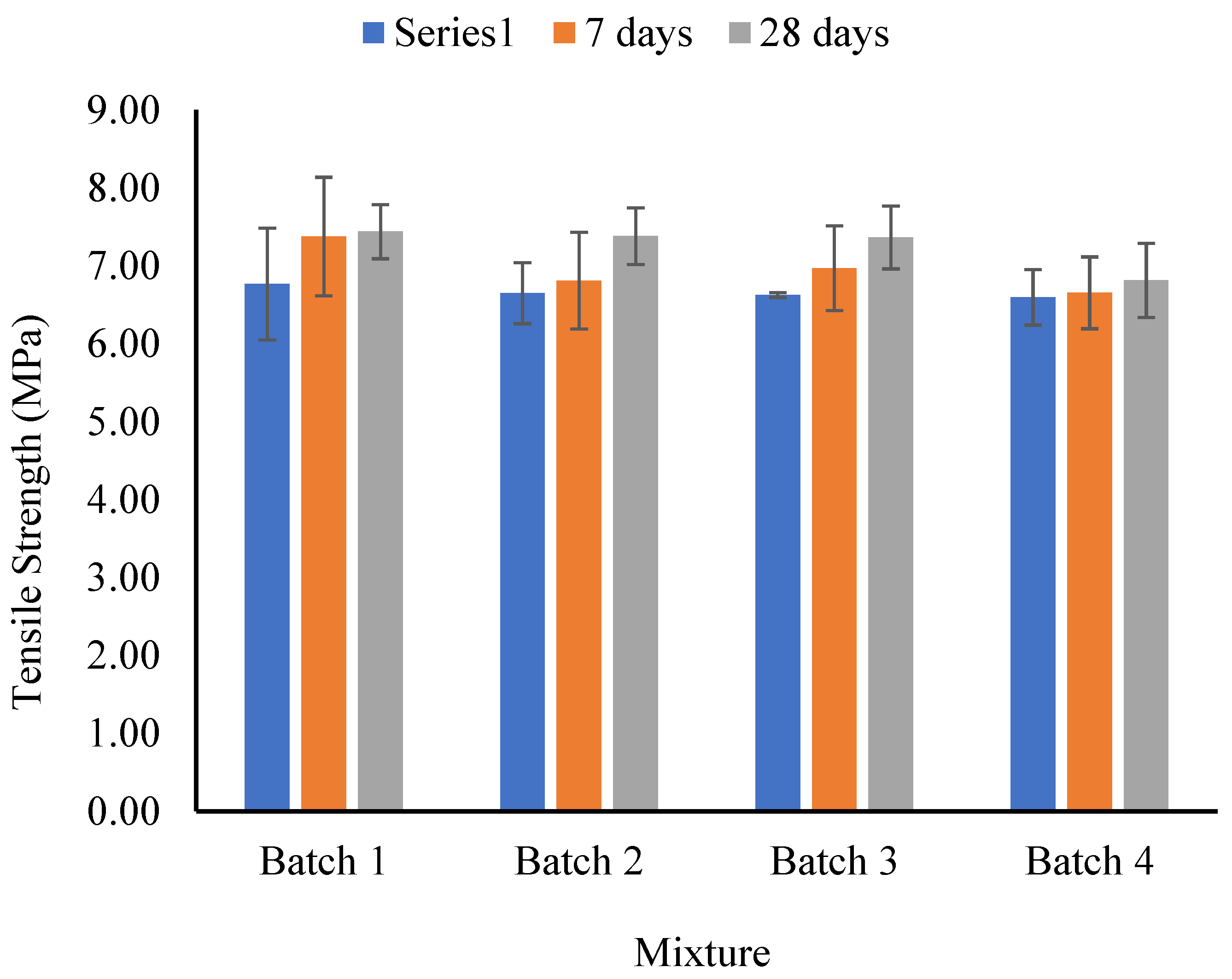

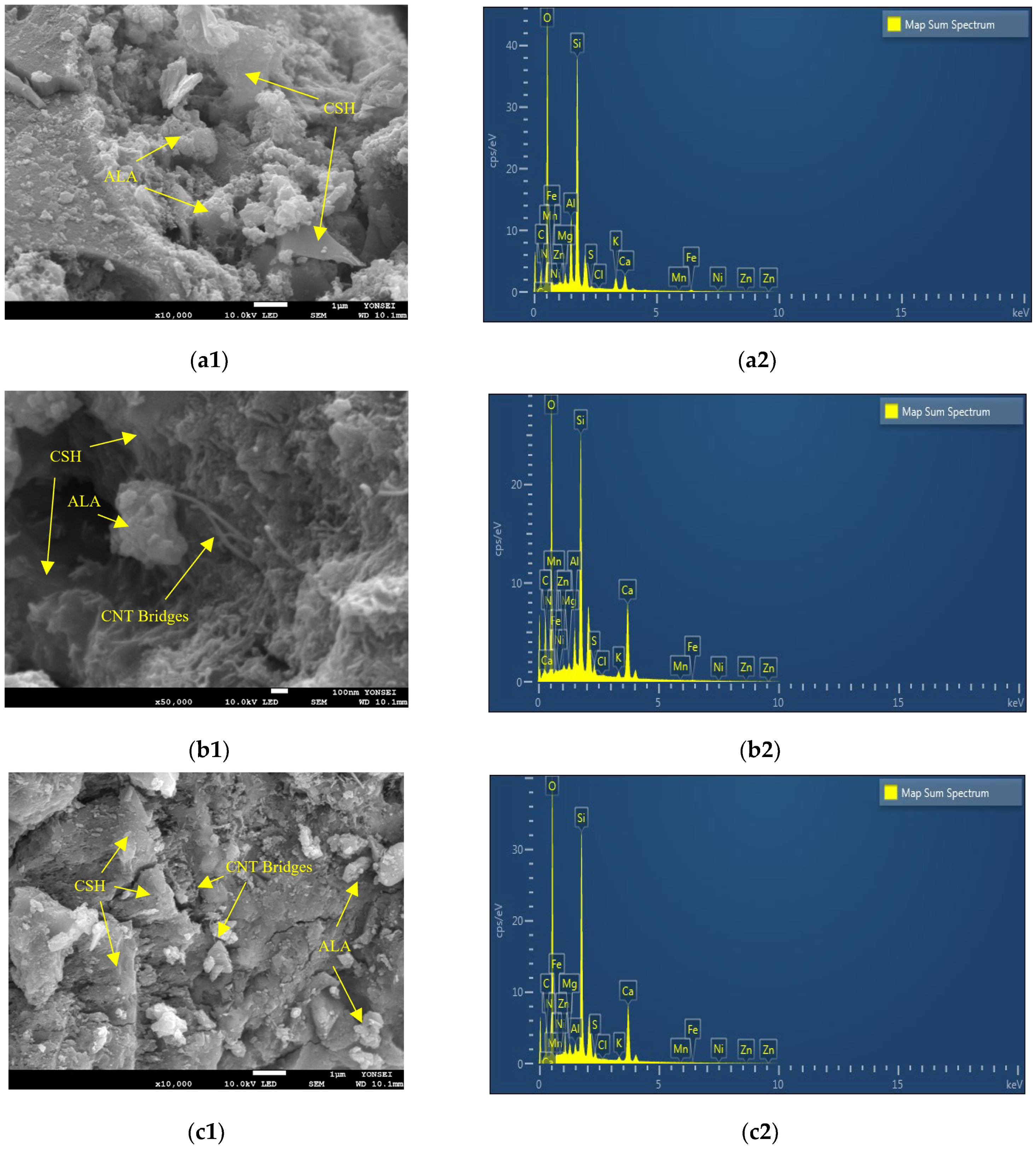
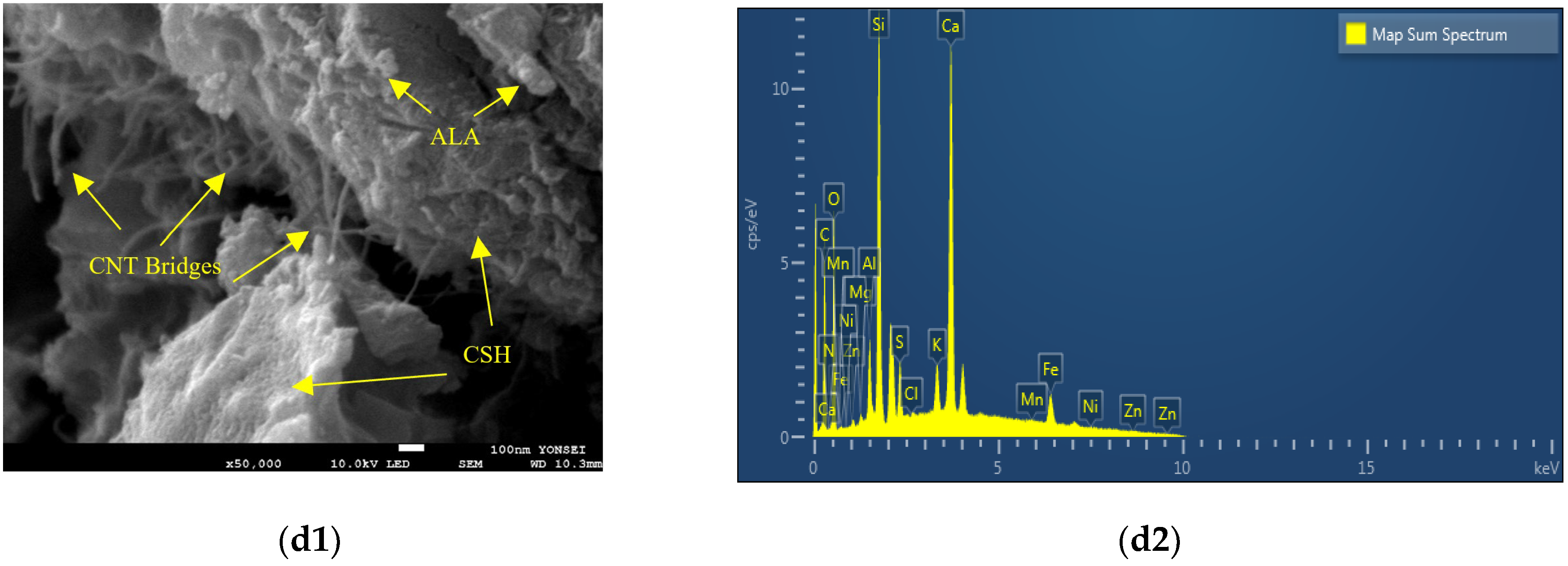
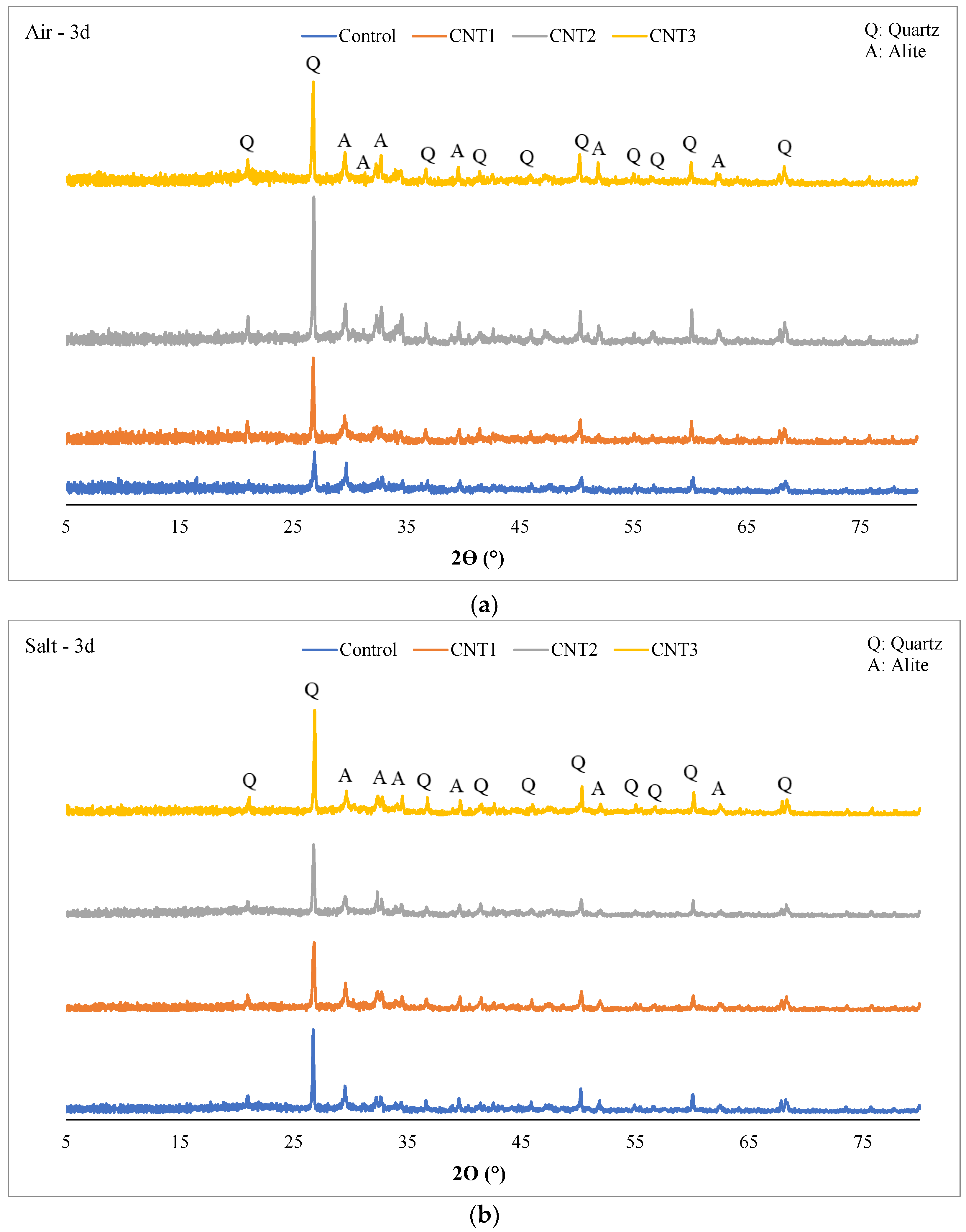


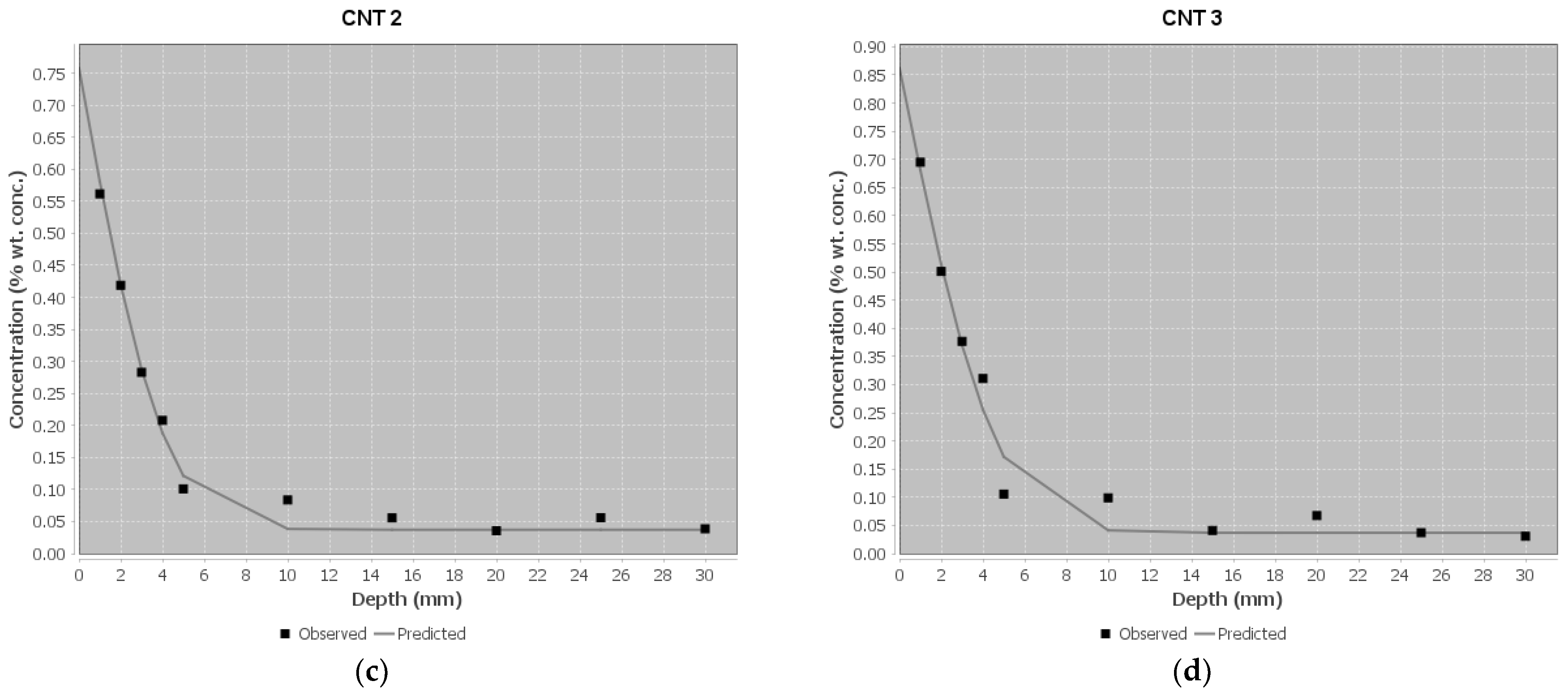
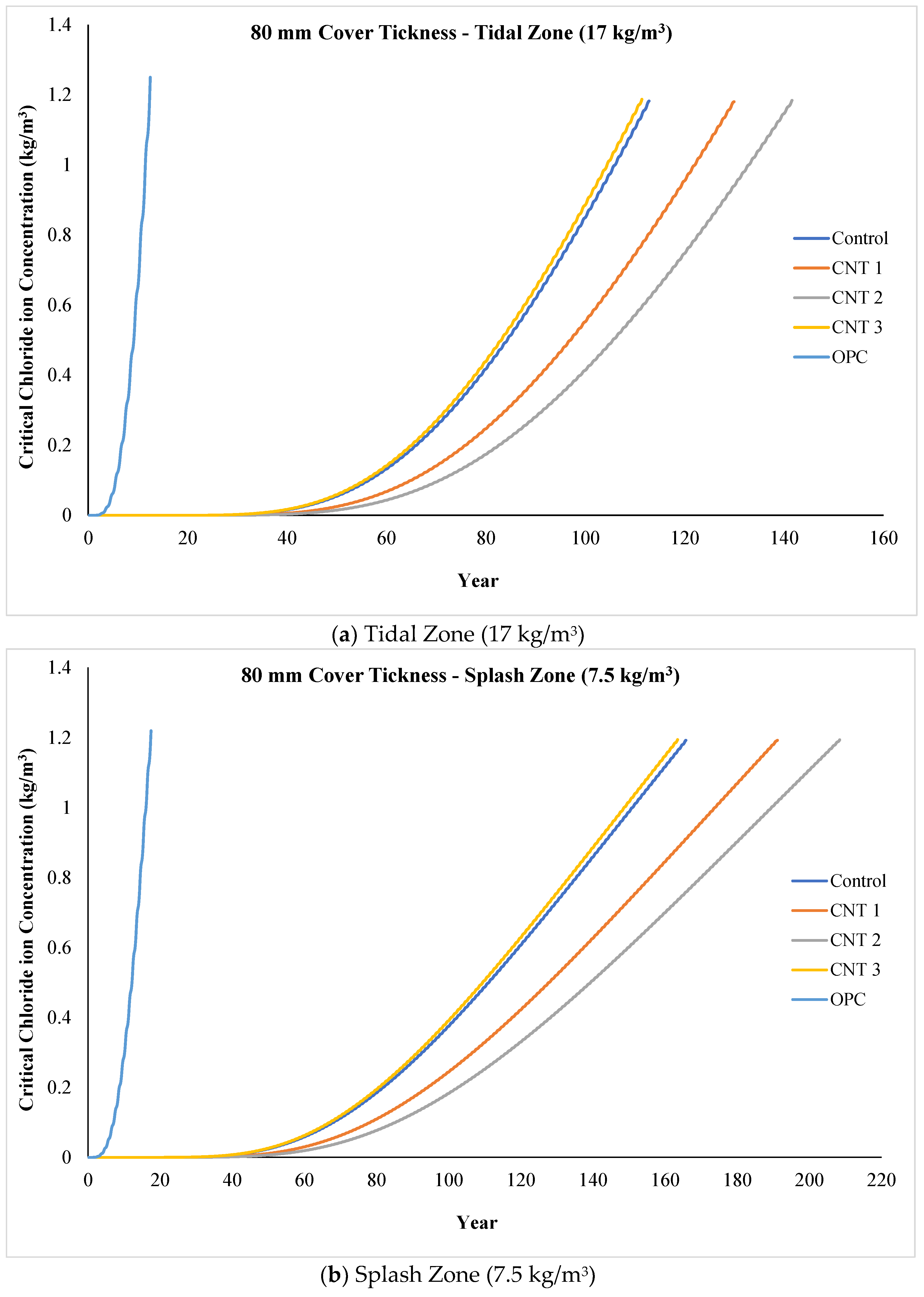
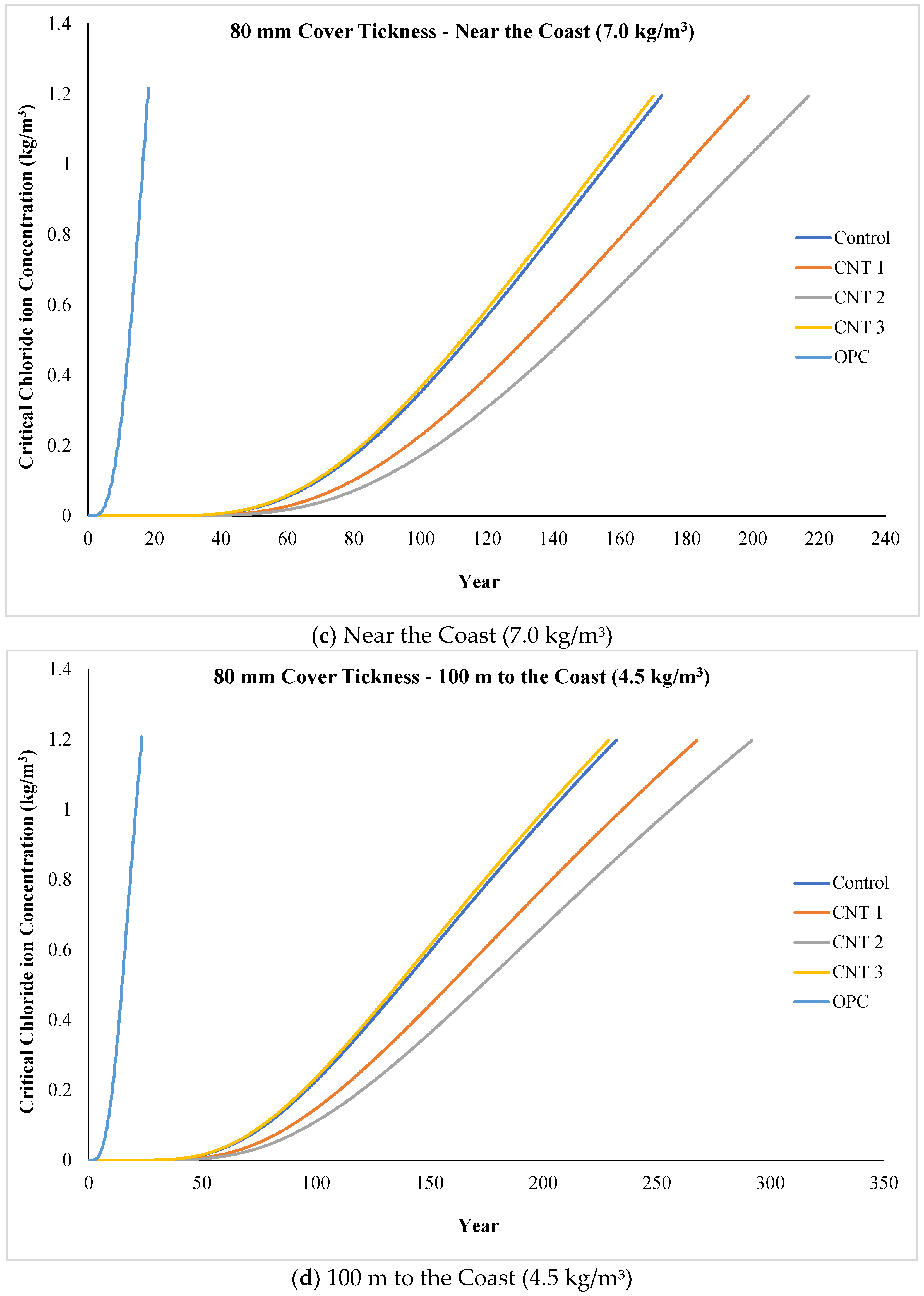
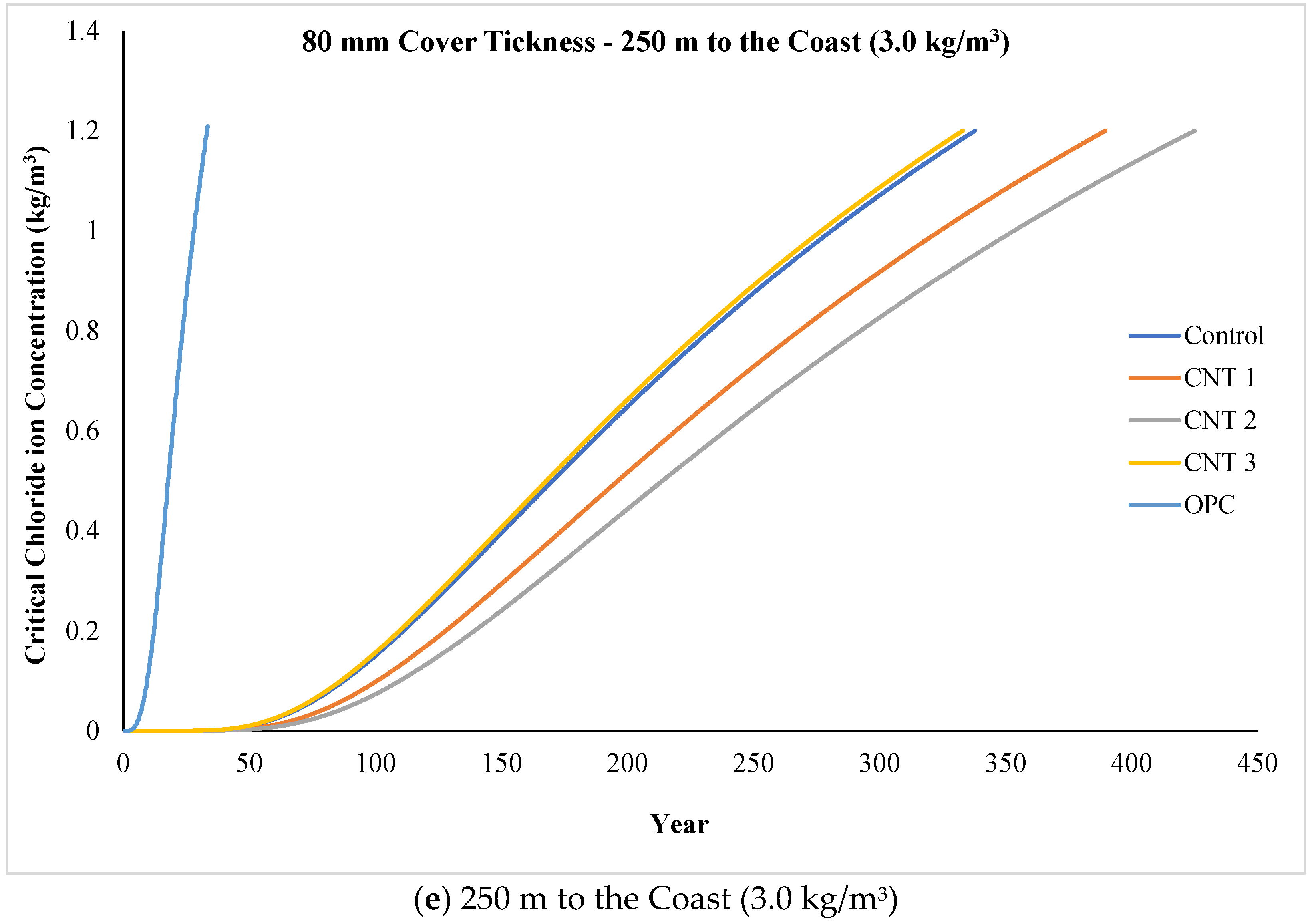
| Chemical Component | SiO2 | Fe2O3 | Al2O3 | TiO2 | CaO | MgO | SO3 | MnO | ZnO2 | Na2O | P2O5 | K2O |
|---|---|---|---|---|---|---|---|---|---|---|---|---|
| MHS | 81.34 | 0.04 | 0.17 | 0.03 | 13.3 | 0.06 | 0.2 | 0.01 | 0.02 | 4.02 | 0.81 | 0.02 |
| OPC | 18.78 | 2.76 | 4.72 | 0.31 | 65.97 | 3.14 | 2.56 | 0.13 | 0 | 0 | 0.19 | 0 |
| SPW | 99.59 | 0.023 | 0.315 | 0.042 | 0.013 | 0.006 | 0 | 0 | 0 | 0.008 | 0 | 0.004 |
| Physical Properties of MHS | |
|---|---|
| Shape | A hollow sphere with thin walls |
| Composition | Soda-lime borosilicate glass |
| Color | pale white powder |
| Pressure resistance (90% survival) | 18,000 psi |
| Medium particle size | 30 microns |
| Softening point | 600 °C (1112 °F) |
| Specific Gravity | 0.6 |
| Thermal conductivity | 0.05–0.20 W·m-1·K-1 @ 20 °C |
| Permittivity (@100 MHz) | 1.2–1.9 |
| Lable | Water (kg) | Binder | Aggregate | CNT (kg) | SP (kg) | |||
|---|---|---|---|---|---|---|---|---|
| OPC (kg) | SF (kg) | SPW (kg) | MHS (kg) | ALA (kg) | ||||
| Control | 212.5 | 739 | 111 | 208 | 211 | 111 | 0 | 7.85 |
| CNT 1 | 212.5 | 739 | 111 | 208 | 211 | 111 | 0.21 | 7.85 |
| CNT 2 | 212.5 | 739 | 111 | 208 | 211 | 111 | 0.43 | 7.85 |
| CNT 3 | 212.5 | 739 | 111 | 208 | 211 | 111 | 0.64 | 7.85 |
| Coastline | Expose Condition | Surface Chloride Concentration (kg/m3) |
|---|---|---|
| West and south coast | Tidal Zone | 17.0 |
| Splash Zone | 7.5 | |
| Near the coast | 5.0 | |
| East coast | Tidal & Splash Coast | 13.0 |
| Near the coast | 7.0 |
| Coastline | Expose Condition | Surface Chloride Concentration (kg/m3) |
|---|---|---|
| West and south coast | Near the coast | 5.0 |
| 100 m | 2.0 | |
| 250 m | 1.5 | |
| East coast | Near the coast | 7.0 |
| 100 m | 4.5 | |
| 250 m | 3.0 | |
| 500 m | 2.5 | |
| 1000 m | 1.5 |
| Ref. | w/b Ratio | Compressive Strength (MPa) | Tensile Strength (MPa) | ||
|---|---|---|---|---|---|
| 3 Days | 28 Days | 3 Days | 28 Days | ||
| This study | 0.25 | 100 | 105 | 6.5 | 7.0 |
| [6] | 0.18 | 80 | 130 | - | - |
| [7] | 0.225 | 100 | 139 | - | - |
| [9] | 0.27 | 55 | - | 6 | - |
| [11] | 0.18 | - | 180 | - | 8 |
| [13] | 0.18 | 80 | 140 | - | - |
| [14] | 0.22 | 60 | 120 | 5.8 | 6.3 |
| Sample | C_s | C_i | D_a | t |
|---|---|---|---|---|
| Control | 0.78 | 0.037 | 8.18 × 10−13 | 90 |
| CNT 1 | 0.813 | 0.037 | 7.1 × 10−13 | 90 |
| CNT 2 | 0.758 | 0.037 | 6.5 × 10−13 | 90 |
| CNT 3 | 0.862 | 0.037 | 8.3 × 10−13 | 90 |
| Expose Condition | Tidal Zone | Splash Zone | Near the Coast | 100 m | 250 m |
|---|---|---|---|---|---|
| Control (mm) | 98.71 | 66.72 | 63.98 | 47.53 | 32.45 |
| CNT 1 (mm) | 91.90 | 62.11 | 59.56 | 44.25 | 30.21 |
| CNT 2 (mm) | 87.99 | 59.47 | 57.03 | 42.37 | 28.92 |
| CNT 3 (mm) | 99.49 | 67.25 | 64.48 | 47.90 | 32.70 |
| OPC (mm) | 325.07 | 219.72 | 210.69 | 156.51 | 106.85 |
Disclaimer/Publisher’s Note: The statements, opinions and data contained in all publications are solely those of the individual author(s) and contributor(s) and not of MDPI and/or the editor(s). MDPI and/or the editor(s) disclaim responsibility for any injury to people or property resulting from any ideas, methods, instructions or products referred to in the content. |
© 2024 by the authors. Licensee MDPI, Basel, Switzerland. This article is an open access article distributed under the terms and conditions of the Creative Commons Attribution (CC BY) license (https://creativecommons.org/licenses/by/4.0/).
Share and Cite
Rafieizonooz, M.; Kim, J.-H.J.; Kim, J.-S.; Jo, J.-B. Effect of Carbon Nanotubes on Chloride Diffusion, Strength, and Microstructure of Ultra-High Performance Concrete. Materials 2024, 17, 2851. https://doi.org/10.3390/ma17122851
Rafieizonooz M, Kim J-HJ, Kim J-S, Jo J-B. Effect of Carbon Nanotubes on Chloride Diffusion, Strength, and Microstructure of Ultra-High Performance Concrete. Materials. 2024; 17(12):2851. https://doi.org/10.3390/ma17122851
Chicago/Turabian StyleRafieizonooz, Mahdi, Jang-Ho Jay Kim, Jin-Su Kim, and Jae-Bin Jo. 2024. "Effect of Carbon Nanotubes on Chloride Diffusion, Strength, and Microstructure of Ultra-High Performance Concrete" Materials 17, no. 12: 2851. https://doi.org/10.3390/ma17122851
APA StyleRafieizonooz, M., Kim, J.-H. J., Kim, J.-S., & Jo, J.-B. (2024). Effect of Carbon Nanotubes on Chloride Diffusion, Strength, and Microstructure of Ultra-High Performance Concrete. Materials, 17(12), 2851. https://doi.org/10.3390/ma17122851






